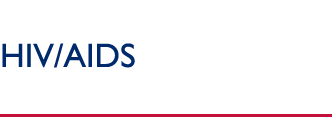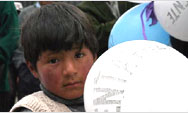Doing Good Business: HIV/AIDS Public-Private Partnerships
Introduction
| |
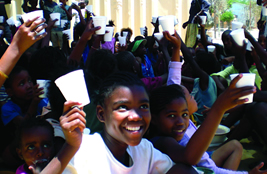 |
| |
A public-private partnership launched by USAID is allowing these
children in Namibia to receive a daily cup of nutritious yogurt, coupled
with HIV/AIDS prevention education. Source: Mary Jordan/USAID |
As part of its endeavor to fulfill the need for quality HIV/AIDS
services, USAID – in cooperation with the U.S. President’s Emergency
Plan for AIDS Relief – designs and enters into public-private
partnerships in developing countries. These collaborations include
USAID and a corporate partner, be it a local firm or a national or
multinational enterprise. Such a partnership may also include a
nongovernmental organization (NGO), the government of a host
country, or both. With more than 20 years of experience in meeting
the challenges of the epidemic, USAID understands that efforts
against HIV/AIDS must be sustained for true development to exist.
Dynamic Partnerships for a Complex
HIV/AIDS Epidemic
Maintaining successful HIV/AIDS partnerships that have a real
impact is key to stemming the epidemic. With this in mind, USAID
embodies the international development belief that a commitment
to local ownership is the best way to support host countries’
investments in their futures. For this reason, USAID enters into
public-private partnerships drawing on unique abilities from local
resources in an effort to keep long-term sustainability on the
forefront of program design. No two partnerships are identical,
but they all share a common feature: Each uses its own distinct
set of combined resources to fill a well-defined need. In doing
so, these partnerships are able to help people who are at risk
of HIV/AIDS, living with the disease, or otherwise affected by it.
Public-private partnerships serve one or more of several purposes,
such as providing HIV/AIDS prevention services, treatment and
care for HIV-positive individuals, or care and support for orphans
and other vulnerable children. Other more programmatic purposes
aim to create jobs or provide skills training for AIDS-affected
individuals, broaden the base of private-sector partners engaged
in public health efforts, and strengthen national AIDS policies in
host countries.
Why HIV/AIDS Public-Private Partnerships
Make Effective Development Programs
The HIV/AIDS public-private partnerships that USAID establishes
in developing countries not only help people who are
affected by the disease, but they also create benefits for the
partners themselves.
Business
Partnerships fulfill a crucial role in social responsibility for a business
and ideally drive the growth of that entity, while increasing the chances
of sustainability for the partnership. Many businesses indigenous
to host countries have experienced financial setbacks as a result
of the AIDS epidemic. Many confront such problems as employee
absenteeism, declines in skilled workers, high rates of turnover, and
increased training and health care costs. Moreover, HIV/AIDS reduces
the demand for consumer goods. When people are ill and unable
to work, they do not have resources to spend on consumer goods
and services. By entering into partnership with USAID, a business
can reduce costs, better protect the health of its employees, or
improve conditions for its customers. By partnering with USAID,
larger multinational corporations can expand their reach into local
host country communities, building relationships with families and
networks of local leaders, and in some cases, offering business
opportunities to vulnerable populations.
Nongovernmental Organizations
In developing countries, many NGOs serve children and adults
who have a complex set of needs resulting from HIV infection
and other factors such as poverty, malnutrition, and insufficient
sanitation. By participating in a USAID public-private partnership,
an NGO is able to avail itself of resources it otherwise might not
have and can then use those resources to strengthen and expand
its portfolio of services.
Host Governments
Host-country governments in developing nations understand the
challenges of keeping their citizens healthy, productive, and secure.
In many cases, governments have not fully established national
systems or the institutional capacity to implement HIV/AIDS
programs of sufficient quality and scope. Through public-private
partnerships, host governments gain access to varied networks,
resources, and knowledge, which they can use to inform and fortify
the systems and institutions they do have in place. They can also help
to ensure that joint initiatives are appropriate to the needs and
culture of the country. In these ways, governments can participate
in the development of services that are effective, enduring, and
ultimately owned by the country. Another advantage to HIV/AIDS
public-private partnerships is that their effects frequently spill over
to influence broader efforts in sustainable development.
How USAID Identifies and Sets in Motion
HIV/AIDS Public-Private Partnerships
There is a lot of variation in the manner by which HIV/AIDS
partnerships are identified and initiated. This flexibility is essential.
Often, USAID must find ways to patch HIV/AIDS services together
with resources and systems that were originally intended for a
different use. To do this repurposing effectively, USAID cannot
rely strictly on convention; it must also see the possibilities that lie
beyond it. USAID nurtures this ingenuity by keeping an ear to the
ground – in both the business and human service sectors of the
developing world. Knowing the capacities of the former, the needs
of the latter, and what it will take to link the two together, is one
reason USAID remains a leader in HIV/AIDS prevention, treatment,
and care.
One challenge in establishing partnerships with businesses is
developing a contribution that is practical for the company and
useful for the benefactors. USAID recently suggested to one
multinational company that manufactures personal care items that
it sell uncut soap to grandmothers caring for grandchildren whose
parents were lost to AIDS. The company will contribute the first
level of inventory, or soap, for the women to begin the project.
Dividing the large soap into small, single-use sachets, the women
will sell their product to local residents living in rural villages. After
generating income from initial sales, the women will purchase the
soap in bulk from the company. Within a short period of time, the
women and grandmothers will be able to support their families.
| Five Steps to Building an HIV/AIDS Public-Private Partnership |
| USAID experts say there are five steps one must take to establish a dynamic public-private partnership. |
| 1. ASSESS: |
Identify industry sectors in-country, such as textiles, and the likely supply chain vendors
needed to support the industry (i.e., transportation). |
| 2. OBSERVE: |
Pinpoint other businesses in the country. Be aware of who is advertising, and where they advertise. |
| 3. ANALYZE |
Recognize and identify U.S. government program needs and the gaps in-country. |
4. STRATEGIZE &
COLLABORATE: |
Develop a public-private partner strategy of mutual benefit. Bring stakeholders together through
open dialogue. |
| 5. HARMONIZE: |
Leverage existing U.S. government resources and current investments to strengthen and scale up programs. |
A Quick Look at More USAID HIV/AIDS
Public-Private Partnerships
There are certain activities whose successful implementation is
central to the success of enterprises. They include marketing,
recruiting, training, logistics, manufacturing, and policy and advocacy.
Because these are core competencies in business, many companies
have personnel who excel in these areas. With the right guidance
and assistance, companies can apply their in-house expertise to
enhancing the HIV/AIDS response – and they often do so in innovative
ways. USAID partners with many companies on a broad
range of initiatives. They include the following:
Coca-Cola – Working in 56 of 57 countries in Africa, The Coca-Cola
Company is the largest private-sector employer on the continent.
Its alliance with USAID supports HIV/AIDS treatment, prevention,
and care for Coca-Cola bottlers’ employees and families. Coca-Cola
is also one of USAID’s nine corporate partners in a job creation
program for orphans, other children affected by AIDS, and their
caregivers. The company has them serve as vendors in their own
communities. As a result, they are able to earn a wage without
leaving their home communities. The program, which currently
runs in Ethiopia, will soon be launched in South Africa. In addition,
Coca-Cola has provided skilled staff to help develop and execute
strategies to disseminate accurate HIV/AIDS information. For
example, Coca-Cola has lent marketing executives to assist in
shaping effective prevention messages. The company has also
contributed its extensive distribution network to the dissemination
of HIV/AIDS-related commodities, including prevention pamphlets.
IAVI-DNAVEC Collaboration– In 2007, the USAID-funded International
AIDS Vaccine Initiative (IAVI) began collaborating on the
development of a novel AIDS vaccine technology using the Sendai virus as a vector to deliver HIV antigens that, researchers hope, will stimulate protective immunity against HIV. IAVI plans to develop and advance into clinical trials a Sendai-based AIDS vaccine candidate in partnership with DNAVEC Corporation, a biotech company based in Tsukaba, Japan.
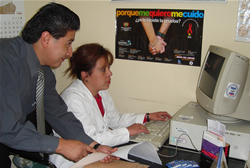 |
“Cultivating HIV/AIDS public-private partnerships pays off. A collective effort can be so much greater than the sum of its parts. Whenever such talent, commitment, and resources cross-pollinate, you get results."
Mary Jordan, Senior Technical Advisor for Public-Private Partnerships, USAID Office of HIV/AIDS |
| Source: USAID/Bolivia |
|
The IAVI-DNAVEC agreement includes pre-clinical testing for immune response and safety,process development for manufacturing, and a Phase I clinical trial for the candidate,with further development to be evaluated after the results of early testing. IAVI and DNAVEC will each contribute scientific and technical expertise. Sendai, an RNA (ribonucleic acid) virus that does not cause disease in humans, is a promising vector in part because it elicits mucosal immune responses. Scientists have recently discovered that the primary sites of HIV replication following infection are the gut-associated lymphoid tissues,which are part of the mucosal immune system. It is therefore possible that in order to provide protection against HIV, a vaccine candidate will need to spur mucosal immune responses.
Pfizer's Global Health Fellows - Skilled Staff Spanning the Globe
 |
|
| HIV-positive mothers from South Africa visit the
White House. Source: White House |
|
Identifying a Need
In 2003, the Pfizer corporation demonstrated public health leadership
by establishing its Global Health Fellows program.
Through this effort, Pfizer contributes its most valuable asset
to HIV/AIDS efforts: its employees. In this way, the company
is helping to address the considerable challenges in expanding access
to, and delivery of, health care in developing countries.
Pfizer has since joined forces with USAID to help to increase the
breadth, quality, and efficiency of the HIV/AIDS programs provided
through the U.S. President’s Emergency Plan for AIDS Relief
(Emergency Plan/PEPFAR).
Initially, the Fellows program was created in response to the high demand for qualified health care workers in Africa.
Pfizer began by loaning medical personnel, such as nurses and clinical practitioners, to partner NGOs and local hospitals
and teaching institutions, such as the Pfizer-initiated Infectious Diseases Institute in Uganda. Over time, however, it became
clear that HIV/AIDS efforts in developing countries needed help overcoming a wider range of challenges in relation to the
support of basic health infrastructure. In order for local providers to offer quality health services, they would need additional
skill sets such as the means to attract, train, and retrain skilled staff; install computer and software technologies; improve
financial and management systems; and develop operational and strategic plans. To assist in the building of health systems
and local capacity, Pfizer is now helping the Emergency Plan address broader challenges by lending not only medical personnel,
but also its financial, organizational management, human resources, and health education professionals. A Commitment to Sustainability
With the support of Pfizer fellows, PEPFAR program grantees are able to address challenges to growth. The Global Health
Fellows program has a focus on sustainable impact and transference of skills and knowledge that is bolstered by a significant
investment in
|
|
|
"Our colleagues bring to the table a set
of skills and expertise, but what they
bring back is a deeper understanding
of the local environment that we may
not always have, as well as a real sense
of what happens on the ground in poorly
resourced areas."
Robert Mallett, Senior Vice President,
Worldwide Alliance Development, Philanthropy
and Corporate Responsibility, Pfizer
|
| |
|
monitoring and evaluation. For example, the mothers2mothers program (m2m) in Cape Town, South Africa,
is expanding its efforts to care for HIV-positive mothers and prevent transmission of the infection to their children. With
the help of one global health fellow, who had expertise in financial management, m2m enhanced and standardized its
operating systems; computerized its accounting processes; developed
financial reports that could be easily understood; and hired and
trained financial support staff. As a result of this capacity-building
effort, m2m was able to open 15 new sites and plan for 17 more.
With the help of two additional Pfizer fellows, the program has
continued to expand its services, now operating in more than 60
sites in South Africa, with plans to expand its services to seven
new sub-Saharan African countries with a grant from PEPFAR.
Long-Term Benefits
Health service providers in the developing world are the intended
primary recipients of the Pfizer Global Health Fellows program,
but the company and its employees also gain extraordinary benefits.
When fellows return to their positions within the company, they
bring with them a broader world vision, a renewed focus on their
work at Pfizer, and new ideas for innovation
Seeing Results
| |
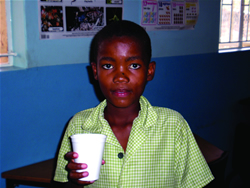 |
| |
A young Namibian boy enjoys a cup of nutritious yogurt. Source: Mary Jordan/USAID |
Leveraging Resources
Has Multiplying Effects
Recently, USAID launched a Namibian public-private partnership in cooperation with Standard Bank, the largest bank on the African continent, Namibia Dairies, and the Namibia Business Coalition on AIDS. Specifically, USAID is providing sachets of nutritious yogurt to young children, coupled with HIV/AIDS prevention education.The yogurt offers children at least one healthy meal supplement per day, helping them to be less vulnerable to HIV/AIDS. Already the program is having an impact. Beginning in February 2008, the program was reaching 400 children per day across two sites. As of March 2008, the number of children attending HIV/AIDS prevention programs has increased twofold.
Modeling Best Practices: Reducing Funding Bottlenecks and Increasing the Number of Vulnerable Children Reached
Building on USAID's successful partnership with Pfizer and the Global Health Fellows program, Standard Bank collaborated with USAID to loan its personnel and expertise in financial management and reporting to local U.S. government-funded NGOs. Child Welfare is the largest NGO of its kind in South Africa, with more than 150affiliates. Yet the organization had little, if any, formal policies and processes in place for financial management and reporting. Today, USAID is supporting the temporary placement of Standard Bank's personnel at Child Welfare, aiding staff in the development and implementation of permanent business procedures. These systems are crucial for the social service NGO to fulfill its mission of serving children and families in the country, as well as to develop and maintain sound fiduciary practices to enhance long-term institutional capacity and organizational growth. This project began in October 2007, and early reports are positive. With Standard Bank's assistance, Child Welfare has reduced reporting delays from nine months to less than 12 weeks.
The U.S. Agency for International Development works in partnership with the U.S. President's Emergency Plan for AIDS Relief.
April 2008 |

